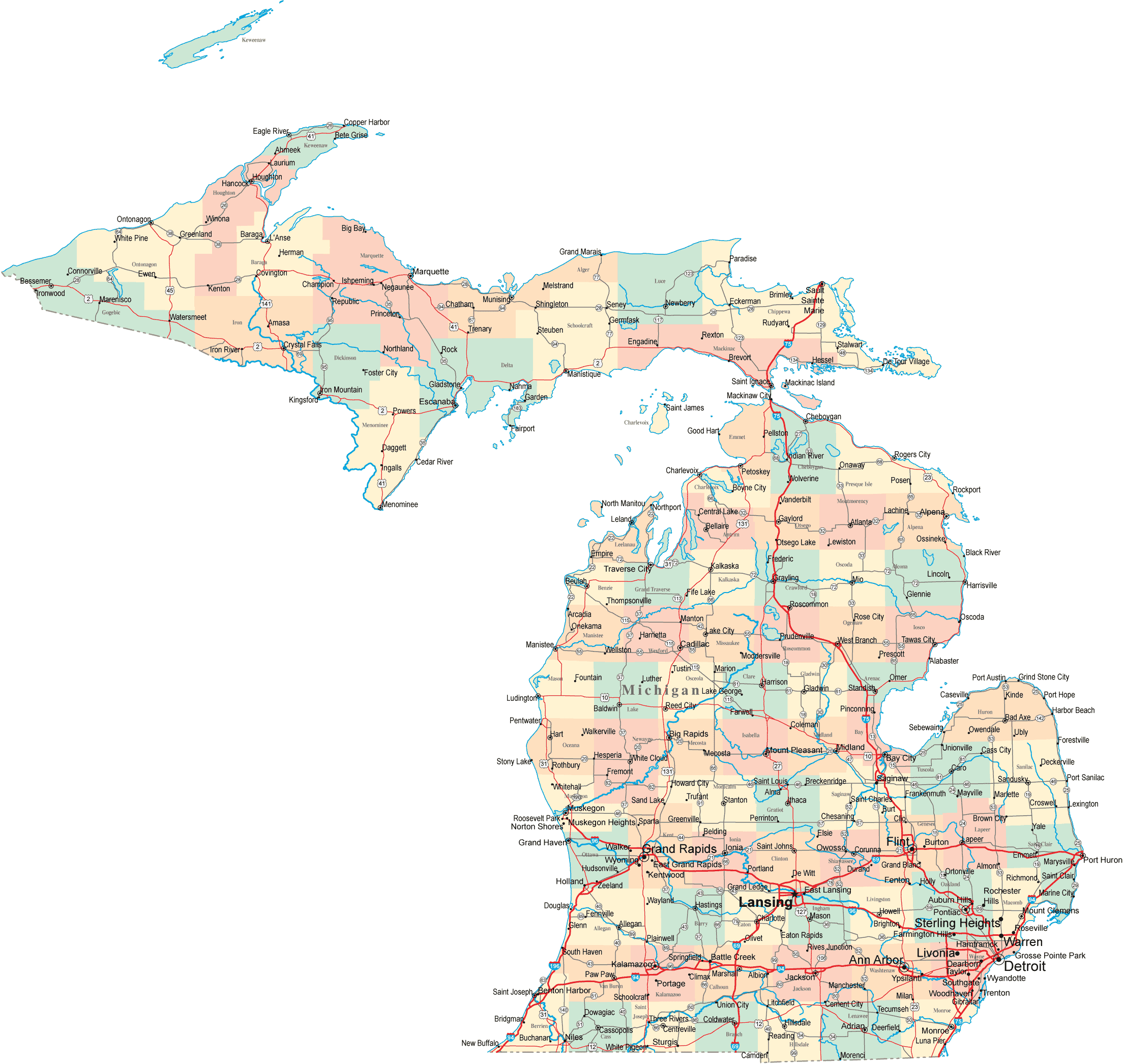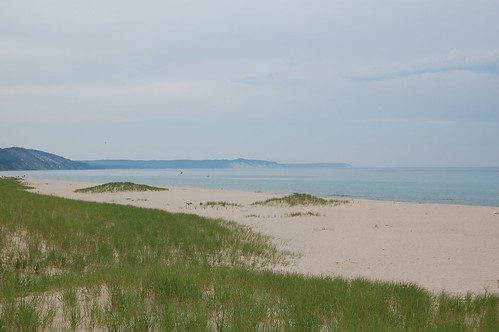Blue Highways: Mount Pleasant, Michigan
Unfolding the Map
 Sometimes we need guidance - a little helping hand to get us where we need to go. Often we seek guidance or signs but cannot find them. Sometimes we don't recognize or even ignore signs we perceive and guidance we receive. William Least Heat-Moon (LHM) asks for guidance and gets it from a deaf woman in Mount Pleasant. It will determine his next destination - the Thumb of Michigan. To place Mount Pleasant on the mitten, put your fingers on the map.
Sometimes we need guidance - a little helping hand to get us where we need to go. Often we seek guidance or signs but cannot find them. Sometimes we don't recognize or even ignore signs we perceive and guidance we receive. William Least Heat-Moon (LHM) asks for guidance and gets it from a deaf woman in Mount Pleasant. It will determine his next destination - the Thumb of Michigan. To place Mount Pleasant on the mitten, put your fingers on the map.
Book Quote
"Across her T-shirt was SKI. She leafed through Stalking the Wild Asparagus in the college bookstore. I was in the middle of Michigan and looking for a place to go next, so I asked whether she lived in Mount Pleasant, but she didn't look up. I tapped her arm.
"'I'm from Missouri. Traveling. I'd like to find a good place to visit in Michigan.' She watched but said nothing. 'Maybe you know a nice spot.' She just stared. Northerners really carry taciturnity too far, I thought.
A clerk came up and said, 'She's deaf. Probably having trouble reading your lips.' He repeated what I'd asked.
"She said, 'Oh,' and put the book down. Holding up her right hand as if to say 'How' in Hollywood Indian fashion, she said, 'Dumb.'
"'Dumb?' the clerk repeated. I didn't know whether she meant me or herself.
"'Dumb Miss Ginn,' she said and wagged her right thumb.
"'Thumb of Michigan?' the clerk asked.
"The girl smiled, wagged her thumb again, and nodded. 'Berry bootful.'
''It's very beautiful,' the clerk translated.
"Looking at her SKI T-shirt, I said, 'Do you ski on the Thumb?'
"'Dumbs due plat. By dames car water ski.'
"'Thumb's too flat to ski,' the clerk said. 'Her name's Karworski.'"
Blue Highways: Part 7, Chapter 15
 Reflections of Mount Pleasant. Photo by Tom Kimball and hoted on the MtPleasant.com website. Click on photo to go to host site.
Reflections of Mount Pleasant. Photo by Tom Kimball and hoted on the MtPleasant.com website. Click on photo to go to host site.
Mount Pleasant, Michigan
Sometimes, we need a guide, and we can't find one. We cast about, looking for the right way or the right path, and no matter what we do, we can't distinguish which way to go. We even ask those we see around us what way might be the right way. Sometimes they are just as lost as we are, and we are frustrated because we want the answer. Sometimes they appear to know exactly where they are going and what they are doing, and we are frustrated because we feel we should know.
For example, my wife has been looking for a sign or a guidepost or an actual guide to give her some indication as to what path her life should take in her middle age. It has been very hard for her. No stroke of inspiration, no accidental dropping of words that gives her a great idea, no light shining out of the grayness of the clouds that illuminates the forest path down which she should tread. She often feels on her own.
In a way, waiting for a sign or a guide to step forward is like waiting for lottery ticket numbers to come up with the multi-million dollar winner. Lightning will strike very few of us, and flashes of inspiration and insight will come infrequently. A guide will step out of the trees only once in awhile. Mostly we are on our own and have to make our own way through the world, relying on our own senses to get us where we need to go.
That's small consolation when you're waiting for that guiding hand. Humans have created religion to provide us with direction, and over the millenia we've prayed to a myriad of gods to provide us with what we need, and we wait. And wait. And wait. We go to psychotherapy in search of the answers, and are frustrated when the therapist asks us a simple question: "What do you think you ought to do?" If you're like me, your first response is often just as direct: "Aren't I paying you to tell me?"
There's a joke I heard once about a man stuck on a roof as flood waters rise about him. He is a deeply religious man, and he begins to pray. After a while, a man comes by in a rowboat, and asks if he needs help. The man on the roof says "Don't worry about me, God will provide." Later, as the water is rising higher, another boat comes by the praying man, and the rower asks him if he wants to get in. "God will provide," says the man. As the man continues to pray, the water rises until it is almost covering the roof. Another boat comes by, and they really want to pull the man in but he resists, strongly saying "God will provide!" They go away and by and by the man drowns. As he is being conducted by St. Peter through the pearly gates, he exclaims "I don't understand. I'm a pious man. I pray every day. I prayed throughout the flood knowing that God will provide. Why didn't he save me." St. Peter turns and says, "Well, God sent you three boats. What else were you looking for?"
I'm learning that inspiration and guideposts must come from within as well as without. Here's my theory. Inspiration and guidance consist of two things: action and recognition.
Nothing will happen if the person seeking guidance doesn't take action. This could be choosing a path or asking for help. Robert Frost provides an example in his great poem The Road Not Taken. He chooses the road less traveled, which has made all the difference, knowing that he may lament not taking the other road. However, this involves action. If we come to a crossroads, and there are no signs, we have to choose or we will remain stuck. Who knows - the signs may be over the next hill, but we have to keep traveling down the road.
We also have to recognize signs and guidance when it is being offered. How many times have I blown off somebody's advice, because I knew better, only to learn later that the advice was correct? How many times have I ignored what my conscience or gut feeling was telling me, only to pay later for ignoring my instincts? Sometimes guidance comes from people or things we don't expect. Literature is rife with people ignoring advice or signs at their peril. Shakespeare made the fool an important part of many plays, and his heroes that didn't pay attention to their seemingly foolish but challenging and wise words often suffered. I think that in most cases, we instinctively know what is true and right but we don't trust ourselves enough to follow our senses and ultimately be our own guides.
In the end, signs can point us to things, but we move past them. Guides usually are with us a short way along our journeys, but not throughout life. They may point out a path or a place we should go, or they may accompany us a short way. Virgil served as Dante's guide through The Inferno, but after the tour was over, Dante had to move on. Our lives are our own, and ultimately, we are responsible for our paths.
LHM ends up on the Thumb of Michigan because he takes action and asks for some advice from a young woman. She was his guide for a short moment in time, and he followed her advice. Occasionally, guidance comes, sometimes even in the form of a young but friendly deaf woman in a bookstore in Mount Pleasant. We just have to recognize the signs.
Musical Interlude
This Ace of Base song, The Sign, is probably one of the last true pop songs to which I paid some attention. It wasn't long after this came out that I stopped listening to pop music entirely. I know I've probably missed a few signs, but I believe I've gained in understanding by broadening my musical knowledge base. That being said, this catchy tune is about recognizing signs and going with it. The best line, if a little grammatically awkward, is "No one's gonna drag you up to get into the light where you belong."
If you want to know more about Mount Pleasant
Central Michigan Life (student newspaper)
Central Michigan University
City of Mount Pleasant
Downtown Mount Pleasant (blog)
Isabella County
The Morning Sun (newspaper)
Mount Pleasant Convention and Visitors Bureau
Wikipedia: Mount Pleasant
Next up: Midland, Michigan




 Friday, April 6, 2012 at 1:07PM
Friday, April 6, 2012 at 1:07PM

